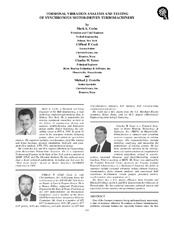| dc.description.abstract | One of the foremost concerns facing turbomachinery users today is that of torsional vibration. In contrast to lateral rotordynamics problems, torsional failures are especially heinous since the first symptom of a problem is often a broken shaft, gear tooth, or coupling. The difficulty of detecting incipient failures in the field makes the performance of a thorough torsional vibration analysis an essential component of the turbomachinery design process. The primary objective of this tutorial is to provide such a procedure for the special case where the turbomachine is driven by a synchronous motor. Synchronous motors are one of the most notorious sources or torsional vibration problems because of the large pulsating torques they generate during startups. The torsional shaft stresses generated by these large pulsations are usually greater than the shaft material endurance limits, thereby, causing the lives of such machines to be limited. The determination of the number of startups that these machines can survive is, therefore, a critical portion of their design process. It is the authors’ experience that there is a great deal of confusion over the proper way to do this. The full impact of this confusion was seen on a recently designed compressor train where the use of one method showed the allowable number of starts to be zero while a second procedure predicted infinite life. In an attempt to alleviate this confusion, a logical, step-by-step procedure, based on the strain-life theory of failure, was generated and is presented herein. An example illustrating how the authors used this procedure to design a critical 66,000 hp air compressor is also presented. The authors believe that employment of this method may well save the user from the need to introduce an expensive and unwieldy Holsetstyle damping coupling into some future compressor train. Although the presented analytical procedure is quite rigorous, there are cases, especially on critical equipment, where it is wise to augment its predictions with torsional test data taken from the field. The best way to do this in synchronous mo*tor-driven equipment is to apply strain gauges to critical shafts in the drive train and measure the actual torques that are generated during startup. Accordingly, a general description of strain gauge testing fundamentals is provided to familiarize all users with it. Additionally, the use of this valuable testing procedure is illustrated via the same 66,000 hp air compressor that was used to illustrate the analytical procedure. The tutorial closes with a comparison of the obtained analytical and test results and an illustration of how the authors used the testing to “fine-tune” the analytical results. | en |


